
The 1963 Indianapolis 500
Atlas F1 Senior Writer
As the 87th race of the Indianapolis 500 is held this coming weekend, Atlas F1's Thomas O'Keefe looks back at two important events in Indy's history, as it intertwined with Grand Prix racing. This week he tells the story of the 1963 Indy 500 - Jim Clark's first year at the Speedway, and the year Grand Prix cars came to Indy in a big way...
The Men and their Machines
At the center of this study in contrasts were two men and two cars that could not have been more different but were destined to make history together. Parnelli Jones was as red-blooded an American race car driver as you could ever possibly imagine. Born Rufus Parnellie Jones in Texarkana, Arkansas, on August 12th 1933, by the time he was a teenager his family had moved to car crazy Southern California where he began at a young age souping up hot rods and honing his driving skills on everything from jalopies to dirt track sprint cars where he finally made his name, winning at 27 years old the 1960 USAC Midwestern Sprint Car Championship.
Jones's car owner was J.C. Agajanian, a flamboyant, mustachioed Armenian-American entrepreneur and racing promoter in a ten-gallon hat whose core family business in Southern California was trash removal and hog farming. That was how he paid the bills. But Indy was the real family business and Agajanian had already tasted victory once, in 1952, when 22 year-old Troy Ruttman won in a white dirt-track car with a red flame paint job licking back from the nose to the engine cover.
The car Agajanian hired Parnelli Jones to drive for the 1963 Indy 500 was not a new car, but it perfectly typified the final playing out of the front-engined roadster type that had been begun by others but perfected by A.J. Watson, who built 23 "Watson Roadsters" in his tiny garage in Glendale, California, of which Jones's car was among the prettiest.
The car had a name: it was called "Calhoun". J.C. Agajanian placed his order with A.J. Watson for Calhoun after cars built by another race car builder for Agajanian failed to qualify for both the 1958 and 1959 Indy 500s. In its debut race, the 1960 Indy 500, Calhoun was painted candy-apple red with silver numbers and a yellow splash on the nose and driven by Lloyd Ruby, a rookie from Texas who was up to third place late in the race until he stalled Calhoun in the pits, recovering sufficiently to finish up in seventh place.
For the 1961 Indy 500, J.C. Agajanian signed up Parnelli Jones as his driver and had a new paint scheme commissioned for Calhoun: most of the body was painted in pearl white with a dash of royal blue and red on the nose of the roadster, which was a very distinctive nose with two "nostrils", a design feature on the Watson roadster that was reminiscent of the contemporary 1961 shark-nosed Ferrari Grand Prix car. A thin blue and red pin-striping feature strip was carried back the length of the car. The exhaust pipe emptied out on the left side of the car just before the left rear tire.
He had to give up the lead to A.J. Foyt on lap 80, when Jones took to the pits with a sick engine, ultimately finishing twelfth, eight laps down to A.J. Foyt, who scored his first win in the 1961 Indy 500 in the Bowes Seal Fast Special. Jones was named co-Rookie-of-the-Year even though he did not even finish in the top ten because of his storming and courageous performance. The rear-engined Cooper, though underpowered at 167 cubic inches by comparison to the 252 cubic inch front-engined roadsters, was reliable and easier on fuel and tires and finished a creditable ninth place.
In the 1962 Indy 500, the by now two year-old Watson roadster was refurbished and updated by Agajanian's Chief Mechanic Johnny Pouelsen and Eddie Kuzma, another California race car builder. Pouelsen and Kuzma re-shaped Calhoun's bodywork, lowered the car's center of gravity and added 15-inch wheels to go along with wider Firestone tires. The tweaks worked as Jones qualified Calhoun on pole and became the first car ever to qualify at Indy at more than 150 mph.
Calhoun looked to be a sure winner, leading 120 of the first 125 laps, but then Jones discovered that he had a brake line failure when he came in for pit stops and the crew took to stacking up tires for Jones to hit and rub off speed, grazing the pit wall too, so that he could slow down and stop for fuel and new tires. Notwithstanding the absence of brakes throughout much of the race and the inherent delays in performing two pit stops using the tire barriers to slow Calhoun down, Jones managed to stay in the fight and finished in seventh place, the same position Lloyd Ruby had managed with Calhoun in 1960.
In the grandstands at the 1962 Indy 500 that day was Colin Chapman, the owner of Team Lotus, who came as a guest of American Dan Gurney, to see the Greatest Spectacle in Racing. These were heady days for Chapman and Team Lotus. Just 10 days earlier, Chapman and his driver Jim Clark had run for the first time the innovative Lotus 25 monocoque chassis in the Dutch Grand Prix.
Agajanian's usual car number "98", was painted with a gold damascene finish surrounded in red on the blue nose and the gold-painted number was outlined in blue on the rear flanks of the car against the pearlescent white. Hung off the left side of Old Calhoun was the external oil tank, which also had "98" on it. The car was officially known as Agajanian's Willard Battery Special. In 1963 race trim, Old Calhoun weighed about 1,600 pounds and its 4-cylinder 252 cubic inch Offenhauser engine produced about 450 horsepower on a nitro-methanol fuel mixture. It looked as if the Armenian millionaire and his crew-cut driver were finally ready to take the refined and refurbished Old Calhoun's most serious run at winning the Indy 500.
But not without a fight. Back in England, Colin Chapman's Lotus 25 had been setting the world of Grand Prix racing on fire and after some initial teething problems, the Lotus 25 and principal Lotus driver Jim Clark would end up winning the 1963 World Drivers' and Constructors' Championships in Formula One. After Chapman surveyed the competition in the course of attending the 1962 Indy 500, he entered into a joint venture with Ford Motor Company brokered by Dan Gurney, pursuant to which Ford agreed to supply a full race version of the Ford Fairlane V8 stock block engine to be installed at the rear of the Lotus 29, an elongated version of the Lotus 25 with the suspension offset to the left for oval racing that would end up weighing 1130 pounds.
Jim Clark had tried a stock Grand Prix Lotus 25 with its Coventry-Climax V8 engine at the Indianapolis Motor Speedway on Wednesday October 10th 1962, just after finishing first in the 1962 U.S. Grand Prix at Watkins Glen. There it sat in the Autumn sun in Indiana, British racing green with yellow pin striping, yellow alloy wheels, Race Number "9" still on the car from the Glen. This was the 1.5 litre (91 cubic inches) era in Formula One and the car being used, chassis R2, was the one raced at Watkins Glen by Trevor Taylor, Clark's teammate, which had finished in twelfth place. The Coventry-Climax engine produced about 175 horsepower. (Lotus was saving Clark's car for the last race of the 1962 season, the South African Grand Prix, which would determine the Formula One Championship.)
Jim Clark was born on March 4th 1936 in Kilmany, County of Fife, Scotland, and was 27 years old - three years younger than Parnelli Jones - when they first competed against one another in the 1963 Indy 500. Unlike Parnelli Jones, who grew up in sunny California, Jim Clark and his friends learned their craft in windswept airfields in England and Scotland, sometimes having to shovel away the snow themselves to uncover the racetrack.
Although blindingly fast in everything he drove, Clark was a quiet and shy type, who rarely displayed in public the arrogance one might expect of a driver who dominated his era in anything he touched: sports cars, Grand Prix cars and eventually, oval racing; he even tried American stock cars once or twice, including a giant Ford Galaxie at Brands Hatch in England and a Holman and Moody-prepared NASCAR Ford at Rockingham, North Carolina. In essence, he was a Scottish farmer, having spent his teens helping his father farm a 1200 acre sheep farm laid out around a stone farmhouse called Edington Mains, near Duns, Scotland.
This is one thing that really annoyed me. They treated me like a kid who had never raced before. On the first occasion I took things easily and tried to get the hang of driving around left-hand corners all the time. Remember the car had come straight from Watkins Glen so it was running on normal racing tyres and was not set up for left-hand turns only and the banking.
I did about 100 laps on that occasion and I remember thinking that it was a bit dull. My fastest lap of 143 mph average made most people sit up and take notice, but what made them even more interested was the speed at which I was taking the turns. The Indy cars rely on their acceleration between the bends to give them their high lap times, and the fastest times an Indy car had recorded in the turn was something like 138 mph. Our Lotus was doing over 140 on the corners. . ."
Modest though he was, Jim Clark surely looked forward to demonstrating to the Railbirds that the young Scot and the strange little green car ridiculed as a "funny car" was more than a match for the front-engined roadsters that ruled the roost at Indy.
Qualifying
While Parnelli Jones and J.C. Agajanian had the luxury of spending the month of May 1963 at the Speedway dialing in Old Calhoun for May 30th 1963, that month was a whirlwind for Jim Clark and Team Lotus. On Saturday, May 11th, Clark competed in the BRDC International Trophy race at Silverstone and finished in first place in the Lotus 25 Grand Prix car. On Saturday, May 18th, Clark reported to Indy for qualifying in the Lotus 29 Indianapolis car, with 200,000 people watching, as the battle between Them and Us began to take shape. Parnelli Jones rose to the occasion and Old Calhoun, always a good qualifier, took pole position at 151.153 mph in dangerous gusty conditions, Jones hugging the white line at the apron of the racetrack. Appropriately, this was the very last time a front-engined car was to be on pole at Indy.
In all, there were four rear-engined cars in the field, Ford vs. Chevy. Mickey Thompson had two low-slung rear-engined chassis of his own construction and design, with aluminum block, 255 cubic inch, Chevy V8 engines. Earlier in the month of May, Clark's fellow Grand Prix colleague and reigning Formula One champion, Graham Hill, had passed his rookie test in Thompson's newest car but later on hit the wall in Turn 3 and never made the race. Gurney too had kissed the wall during a practice session in Turn 1, writing off No. 91, his original car (chassis 29/2), which is why Gurney ended up qualifying the third chassis (chassis 29/1), Clark's back-up car.
After qualifying at Indy, it was back to Europe for Clark, Hill and Gurney for the first Championship race of the Formula One season, the Monaco Grand Prix on Sunday, May 26th, which Hill won. Clark and Gurney should have stayed at Indy; Gurney went out after 25 laps with crown and pinion problems in his Brabham-Climax and Clark's Lotus went out while leading with a seized gearbox on lap 78 of the 100 lap race, being classified in eighth place. On Monday morning, Clark began his trek back to the American Midwest taking the early plane from Nice to London, and flying from there to Chicago to make the 1963 Indy 500, which was run that year on Thursday, May 30th 1963.
The Race
Back home in Indiana, it was a glorious day for a race. On the farm in Scotland where it was the end of the afternoon and early evening when the race took place, Jimmy's father, James Clark Senior, was on the telephone to the Lotus factory, which had a direct link with Indianapolis; Mr. Clark listened to the commentary from Lotus and relayed the substance to those at the farmhouse at Edington Mains.
There was much for the Senior James Clark to report. As the Chrysler 300 pace car pulled off and starter Pat Vidan waved the green flag, a mighty fight erupted amongst the powerful roadsters, with Jones taking the first two corners but hard-charging Jim Hurtibise in the supercharged Novi very much his equal, racing side by side, up close to the fence for a bit until Hurtibise pulled ahead of Jones on the backstretch to take back the lead from Old Calhoun. The Novi had the honor of leading lap 1, much to the delight of the crowd that had seen the fast but unreliable Novi's go fast but then go out in so many previous Indy 500's.
An early yellow flag came out for then-rookie Bobby Unser, who crashed his yellow Novi in Turn 1; Jones was in the lead when the race re-started and he stretched it out, trying to build up a lead before he had to come in for the first of his three pit stops. Jim Hurtibise in the Novi and Roger McCluskey in the No. 14 black and gold Konstant Hot Special, another fast Watson roadster that was newer than Old Calhoun and was running up front all day, traded second place with Hurtibise's Novi behind Parnelli Jones. By lap 40, McCluskey had the upper hand and passed Hurtibise for second place, 20 seconds down to Old Calhoun.
On lap 67, Jim Clark took the lead, the Watson's of Jones and McCluskey had to pit; and Dan Gurney was now in second place. The Ford executives back in Dearborn, Michigan and the team members listening on the line at the Lotus factory in England must have been giddy with excitement that the one pit stop strategy they planned on from the outset of the Indy project might just work. Would they actually be able to pull this off? James Clark Senior listened attentively to the commentary on the telephone link as his son took the lead and he must have been bursting with pride, as darkness began to fall on the moors of Berwickshire.
Agajanian's crew clearly knew what they were up against and were determined not to repeat the mistakes of prior years with Calhoun and its problematic pit stops. As Jones pulled in for his first pit stop, the car went up on its air jacks and the crew went into action: one crew member put a special tube-like asbestos shroud over the exhaust pipe so that the refueller with the hose and nozzle, Chief Mechanic Johnnie Pouelsen, could get to the aircraft-style gas tank latches located behind the cockpit without starting a fire. Pouelsen held his breath to protect against the toxic fumes while the nitro-methanol blend went in.
A USAC official behind the pit wall held a fire extinguisher at the ready. Meanwhile, other crew members hammered off the knock-off hubs (no air guns in those days) to change three of the four Firestone tires (the left front, which gets the least use at Indy stayed on), Parnelli got a drink, a new set of goggles and a clean windshield and was off in only 22 seconds. To save the clutch, all five crew members pushed the car off as it came off the jacks, grabbing on the roll bar and nerf bars as handles, one mechanic falling to the ground after giving a final oomph to get Old Calhoun underway.
Shortly after Clark's pit stop, the Novi of Hurtibise retired on lap 102 with an oil leak, to the collective sigh of the disappointed crowd, always pulling for the underdog.
By lap 126, Parnelli Jones had long since retaken the lead from Clark but had to go in for his second pit stop. Luckily for him, the second pit stop was virtually identical to the first. Car owner Agajanian calmly watched over the pit crew, stopwatch in hand. Traces of oil could be seen on the rear flanks of Old Calhoun.
On lap 162, taking advantage of a yellow flag, Old Calhoun headed for the pits from the lead for Parnelli's third and last pit stop and in these days of no pit speed limiters, Parnelli was coming in hot and fast. Knowing how critical it was to get Old Calhoun in and out in record time, J.C. Agajanian himself was out on the pit wall in his Stetson hat, by now in a high state of agitation, wildly gesticulating to slow Jones down as he came into the pits, acting as an unofficial number of the pit crew.
Agajanian stopped a rolling tire with his foot from the top of the pit wall; in all the excitement he had even stopped holding his ever-present stopwatch. The external oil tank on the left side of the car near the engine was still relatively clean-looking but windswept streaks of oil were beginning to be visible at the rear of the car, low down under the tail, below the number "98" and by the nerf bars.
Parnelli Jones, the man at the center of all this frenetic activity, was rock solid and the picture of calm and confidence while he waited for the pit stop to be completed, despite knowing that every moment he spent there in the pits, Jim Clark was catching him out on the Speedway in the Lotus-Ford. Again the pit stop was flawless and when Jones rejoined the race with just thirty-eight laps to go, Clark was coming down the front straightaway but Old Calhoun was still in the lead as Jones blasted off down pit lane, exited the pits and headed for Turn 1.
On lap 182, Eddie Sachs, in the newest Watson roadster, the No. 9 yellow and red Bryant Heating and Cooling Special, lost a wheel and crashed in the north chute just ahead of Jones who drove down low on the racetrack to avoid debris from the accident. The yellow flags came out and slowed the field. Sachs had spun into the infield a few laps earlier but had managed to restart: this time, however, he was out of the race.
With only seven laps left, the green flag came out on lap 193. Clark maintained station in second place, 21 seconds behind Jones, whose engine continued to smoke as he backed off in the turns. Clark believed that Jones was dropping oil and made no attempt to chase down the Watson roadster in the closing stages of the race, thinking that the car might self-destruct or be black-flagged by the USAC officials. Indeed, at the drivers' meeting before the race, Chief Steward Harlan Fengler had made a point of telling the drivers that any oil seen discharged from a car would result in immediate disqualification, as had happened earlier in the race to the Novi of Jim Hurtibise.
On lap 198, more evidence was displayed that the track was becoming an oil patch, as Roger McCluskey, who had run in the top ten all day and was up to third in the black and gold Konstant Hot Special, spun in Turn 3, later on blaming the oil being dropped by Old Calhoun as the culprit and the cause of his spin.
Down on the pit lane, Harlen Fengler stood poised to show the black flag to Jones which, at that stage of the race, would have handed the victory to Clark, to Them, to the funny cars. Fengler had been around the Speedway almost from its inception. He had driven in the 1923 Indy 500 forty years earlier to the day and finished down in sixteenth place, completing only 69 laps. Fengler drove that year for Cliff Durant, the millionaire son of William Durant, founder of General Motors. In the 1926 Indy 500, the two switched roles, with Cliff Durant driving a "Fengler" chassis with a supercharged Locomobile engine. In both outings at Indy, Fengler or his car went out early because of gas tank leaks.
It must also be said that Agajanian was a good ole boy around the Speedway and it was rumored that Agajanian actually played a role when Harlan Fengler was first appointed Chief Steward: they were friends as well as fellow sportsman. Agajanian pleaded his case with Fengler, arguing that whatever had happened previously with leakage from Old Calhoun's external oil tank, no oil was currently leaking and the danger had passed. Chapman could stand it no longer and came down off the Team Lotus pit stall and ran down to where Agajanian was cajoling Fengler to join the "dialogue." With the laps ticking down, this is how the Indianapolis Star described the scene of pleas and counter-pleas being made by Agajanian and Colin Chapman to the USAC officials:
In the end, Parnelli was given the checkered flag instead of the black flag as he came around for the 200th lap, with Clark having dropped back 33 seconds. There had been nine yellow flags and the home team made the best of them, nullifying the advantage the Lotus-Ford would have enjoyed had the race been run under green conditions. As an ecstatic Jones wheeled into Victory Lane, the whole left side of the rear flank of Old Calhoun was covered with the oil streaks which were first visible in Parnelli's second pit stop but were now unmistakable smudges all over the rear of the car. In the pit area, Clark returned to the Team Lotus pit box to the sounds of bagpipers and his teammate Dan Gurney, who had been nursing an engine with a broken camshaft and had made an extra pit stop to check on his tires, was satisfied with his seventh place finish.
Dan Gurney had done and would do many wonderful things as a race driver in the years to come but his crucial role as the catalyst for bringing Lotus and Ford together and creating the circumstances for this classic Indy 500 remains one of his singular achievements.
Amazingly, there was no ill will between Clark and Jones after the race. Nor was there lasting animosity between Agajanian and Chapman. Had this been a Grand Prix in Europe, Chapman might have challenged the race officials, but he was wise enough to realize that it would have been pointless in this setting. And in the years to come, Chapman would sell a Lotus or two to Agajanian, who knew that winning what was to be his second Indy 500 had been a close thing.
To round matters out, later on in the Summer of 1963, the Lotus-Fords took on the roadsters on a one-mile oval in the Milwaukee 200 on August 18th 1963, and this time Clark trounced the field, lapping everyone except A.J. Foyt, whom he was coming up on as the race ended. Old Calhoun developed brake problems and was never a contender in the race.
Postscript
Jim Clark would return to the Indianapolis Motor Speedway again and finally won the race in a new Lotus 38 Powered-By-Ford in 1965, leading 190 laps of the 200-lap race and finishing almost two minutes ahead of his old adversary Parnelli Jones, who was now driving the No. 98 "Kuzma-Lotus" Ford called the Agajanian Hurst Special, painted gold.
The Hurst Special that Parnelli Jones was driving was actually Jim Clark's No. 6 Lotus 34 (chassis 34/3), which he had driven in the 1964 Indianapolis 500, going out with tire suspension failure while Clark was in the lead. In a final irony, Parnelli Jones has preserved this car - the one both he and Jim Clark drove - and he keeps it in his museum in Torrance, California, re-painted not as the Agajanian Hurst Special Jones drove but in Clark's green and yellow colors.
Wouldn't it have been perfect if these two drivers who drove the same Lotus at different times in their careers could have been on the same team? It almost happened.
For the 1968 Indy 500, STP's Andy Granatelli and Colin Chapman had forged a joint venture and intended to run a twin turbine team with Jim Clark driving the latest four-wheel drive Lotus 56 with a Pratt & Whitney turbine engine that was dubbed the "flying doorstop" for its wedge shape, and Parnelli Jones slated to drive the STP Oil Treatment Turbine known as "Silent Sam", which had whooshed its way to domination of the 1967 Indy 500, leading 171 laps, only to go out on Turn 4 at lap 197, the proverbial $6 transmission bearing having failed, depriving Jones of his second win. In the archives of the Indianapolis Motor Speedway there is a rare picture of Jones and Clark in their day-glo red STP turbines on the pit lane at Indianapolis, side by side. The picture was taken in March 1968 during a private test session.
But it was not to be. Within weeks of that picture, Jim Clark was killed at a meaningless Formula 2 race in Hockenheim, Germany on April 7th 1968, under circumstances still never satisfactorily explained, but thought to be an accident brought on by tire failure, sending his Lotus 48 F2 car into the trees. He was just 32 years old when he was killed.
Parnelli Jones will celebrate his 70th birthday this Summer and is very much with us. Last year at the Indy 500, I had the honor and pleasure of being taken around the Speedway in a pace car with Parnelli driving, bemoaning the speed limiter as we hit maximum revs on the backstretch and headed for Turns 3 and 4 where Silent Sam let him down. He still remembers Jim Clark fondly and when we pulled off in the infield near the creek in Turn 1, he reminded me that this was the spot where Jimmy's car stopped in the 1964 Indy 500 when the suspension failed at considerable speed on the main straightaway and he wrestled the car to a halt with the deft touch he had in all such circumstances.
As for the pearlescent white, blue and red Old Calhoun and the green and yellow Lotus-Ford that was a worthy adversary that day forty years ago now, both chassis sit parked nearby one another in the Hall of Fame Museum on the grounds of the International Motor Speedway as a reminder to race fans of the Tale of those Two Chassis and the two men who drove them into the history books of the Indy 500.
It was the best of races; it was the worst of races. Although there have been many famous Indianapolis 500 races and many famous cars during the 86 year-old history of the Indianapolis Motor Speedway, the 1963 Indy 500, exactly 40 years ago this week, was the rare bird that combined absolutely everything that makes the Indianapolis Motor Speedway great.
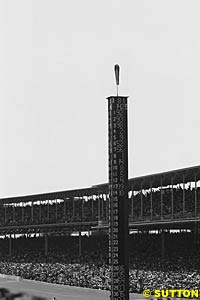 In one three and a half-hour period on May 30th 1963, fans were treated to a titanic struggle between the brutish but spectacularly painted front-engined Offenhauser-powered roadster that had come to dominate the Indianapolis 500 and oval track racing since just after World War II and the lithe rear-engined Grand Prix car painted British Racing Green that represented an entirely different racing tradition bred not on ovals but on the road racing circuits of Europe. Never the twain shall meet like this again.
In one three and a half-hour period on May 30th 1963, fans were treated to a titanic struggle between the brutish but spectacularly painted front-engined Offenhauser-powered roadster that had come to dominate the Indianapolis 500 and oval track racing since just after World War II and the lithe rear-engined Grand Prix car painted British Racing Green that represented an entirely different racing tradition bred not on ovals but on the road racing circuits of Europe. Never the twain shall meet like this again.
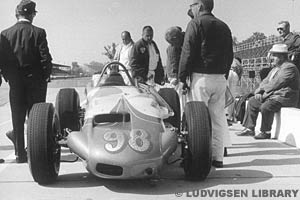 The 1961 Indy 500 was Calhoun's second Indy 500 but Parnelli's first. Jones qualified Calhoun in fifth place. Qualified down in thirteenth was Australian Jack Brabham in his green and white modified Cooper T57 Grand Prix car with a Climax engine in the rear. Jones, though a rookie, won the hearts of the crowd that day, leading the race for 27 laps, despite being injured when he was struck above his eye by a Dzus fastener throw off another car, causing blood from the wound to seep into his goggles as Parnelli soldiered on.
The 1961 Indy 500 was Calhoun's second Indy 500 but Parnelli's first. Jones qualified Calhoun in fifth place. Qualified down in thirteenth was Australian Jack Brabham in his green and white modified Cooper T57 Grand Prix car with a Climax engine in the rear. Jones, though a rookie, won the hearts of the crowd that day, leading the race for 27 laps, despite being injured when he was struck above his eye by a Dzus fastener throw off another car, causing blood from the wound to seep into his goggles as Parnelli soldiered on.
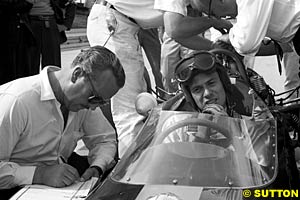 By now, Calhoun was developing a reputation at Indy as a fast but troublesome car but that did not deter Agajanian and Jones from entering the aging Watson roadster, by now known as "Old Calhoun", in the 1963 Indy 500. By 1963, the car had reached the full flowering of its beauty as the prototypical Watson roadster, all decked out with a fabulous pearlescent white body, a bright blue nose with fire-engine red and blue trim that swept back from the nose in a broad feature strip that came to point at the rear of the car, just under the wraparound chrome nerf bar. Aerodynamic shields were added up front on either side of the nose to improve airflow over the front suspension components and a new and longer chrome exhaust pipe was routed under the left side of the cockpit and continued on past the left rear wheel. The cockpit and headrest were changed from red leather to black leather.
By now, Calhoun was developing a reputation at Indy as a fast but troublesome car but that did not deter Agajanian and Jones from entering the aging Watson roadster, by now known as "Old Calhoun", in the 1963 Indy 500. By 1963, the car had reached the full flowering of its beauty as the prototypical Watson roadster, all decked out with a fabulous pearlescent white body, a bright blue nose with fire-engine red and blue trim that swept back from the nose in a broad feature strip that came to point at the rear of the car, just under the wraparound chrome nerf bar. Aerodynamic shields were added up front on either side of the nose to improve airflow over the front suspension components and a new and longer chrome exhaust pipe was routed under the left side of the cockpit and continued on past the left rear wheel. The cockpit and headrest were changed from red leather to black leather.
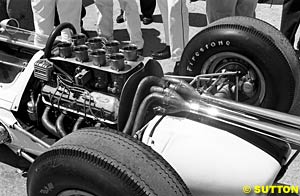 The Lotus 29 was the handiwork of Len Terry who, in later years, would design Dan Gurney's Eagle Grand Prix car. The 255 cubic inch Ford V8 produced about 370 horsepower, which created a favorable power-to-weight ratio. The Ford V-8 had four Weber carburetors and was designed to run on pump gas, and it was hoped that the Lotus-Ford could run the Indy 500 on only one pit stop. The various Lotus 29 fuel tanks scattered around and beside the driver had a capacity of 42 gallons. The 4-cylinder Offy in the Watson roadsters produced perhaps 75 more horsepower, which was needed to overcome the weight penalty inherent in the bulk of the front-engined roadster design.
The Lotus 29 was the handiwork of Len Terry who, in later years, would design Dan Gurney's Eagle Grand Prix car. The 255 cubic inch Ford V8 produced about 370 horsepower, which created a favorable power-to-weight ratio. The Ford V-8 had four Weber carburetors and was designed to run on pump gas, and it was hoped that the Lotus-Ford could run the Indy 500 on only one pit stop. The various Lotus 29 fuel tanks scattered around and beside the driver had a capacity of 42 gallons. The 4-cylinder Offy in the Watson roadsters produced perhaps 75 more horsepower, which was needed to overcome the weight penalty inherent in the bulk of the front-engined roadster design.
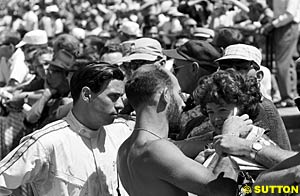 Although Scottish reserve, sincerity and quiet confidence were his predominant character traits, the taciturn Scot could get flustered on occasion and the magisterial Indianapolis Motor Speedway managed to get his dander up. Clark became unusually peevish at what he regarded as the wholly unnecessary "rookie test" procedure he was subjected to when he first went to Indy, as he later recounted in his autobiography.
Although Scottish reserve, sincerity and quiet confidence were his predominant character traits, the taciturn Scot could get flustered on occasion and the magisterial Indianapolis Motor Speedway managed to get his dander up. Clark became unusually peevish at what he regarded as the wholly unnecessary "rookie test" procedure he was subjected to when he first went to Indy, as he later recounted in his autobiography.
"Everyone was very interested in our ploy. After all, it was not every day that someone arrived with a puny little 1.5 litre racing car that produced only 175 bhp on their sacred track, and just to see that I was a good little boy the officials had invited a number of drivers along just to watch me go round and see that I did the correct thing at the correct time.
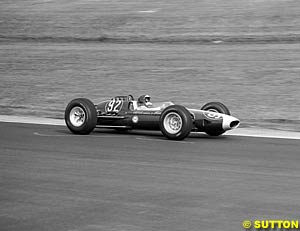 Jim Clark in his green No. 92 Lotus-Ford with yellow racing stripes (chassis 29/3) qualified the rear-engined car in the middle of the second row at 149.75, which placed him just behind crowd-pleaser Jim Hurtibise in the legendary hard-luck, rose-colored No. 56 Novi, sponsored by the Hotel Tropicana. Clark's teammate, Dan Gurney, qualified the Lotus-Ford team car in twelfth place, on the outside of the fourth row. In qualifying, Gurney's car was No. 93 and painted identically to Clark's (it was chassis 29/1, the Lotus 29 prototype "Mule" on which all the development work was done), but before the race it was resprayed in American Racing colors, a white body with blue racing stripes.
Jim Clark in his green No. 92 Lotus-Ford with yellow racing stripes (chassis 29/3) qualified the rear-engined car in the middle of the second row at 149.75, which placed him just behind crowd-pleaser Jim Hurtibise in the legendary hard-luck, rose-colored No. 56 Novi, sponsored by the Hotel Tropicana. Clark's teammate, Dan Gurney, qualified the Lotus-Ford team car in twelfth place, on the outside of the fourth row. In qualifying, Gurney's car was No. 93 and painted identically to Clark's (it was chassis 29/1, the Lotus 29 prototype "Mule" on which all the development work was done), but before the race it was resprayed in American Racing colors, a white body with blue racing stripes.
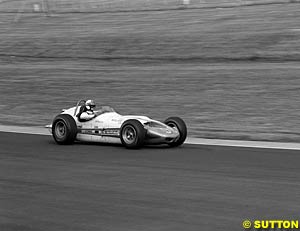 Team Lotus did not challenge the frontrunners in the early stages. Clark made a conservative start and temporarily fell back from fifth to eleventh place, engulfed by the taller, snarling roadsters all around him. Gurney, from his position on the outside of the fourth row was more aggressive and running up close to the wall, passing roadsters on the outside and kicking up the dust as he was fighting his way up toward the lead pack. Gurney had been through the harrowing experience of lap 1 at Indy the year before so in the early laps Gurney was leading the way for Clark, who tucked in behind and in Gurney's slipstream.
Team Lotus did not challenge the frontrunners in the early stages. Clark made a conservative start and temporarily fell back from fifth to eleventh place, engulfed by the taller, snarling roadsters all around him. Gurney, from his position on the outside of the fourth row was more aggressive and running up close to the wall, passing roadsters on the outside and kicking up the dust as he was fighting his way up toward the lead pack. Gurney had been through the harrowing experience of lap 1 at Indy the year before so in the early laps Gurney was leading the way for Clark, who tucked in behind and in Gurney's slipstream.
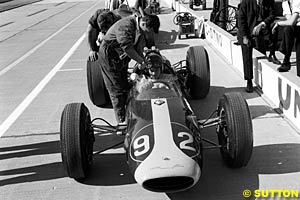 Then it was Jim Clark's turn. Clark came in to pit on lap 96 - almost halfway through the 200 lap race - for his one and only pit stop but it did not go smoothly. Team Lotus had a special full-body jacking platform to raise the car up pneumatically once it came in but as Jimmy approached the lift a crew member motioned to slow down and Clark did just that, but came almost to a halt as he got to the lift and the car lost momentum. The crew virtually dragged the Lotus-Ford into the proper position on the lift so the car could be jacked up and the tires changed, losing valuable seconds in the process. One crew member gave Jimmy clean goggles and opened the breather vent for the gas tank in one elegant motion, as Clark gratefully slugged down a cup of water.
Then it was Jim Clark's turn. Clark came in to pit on lap 96 - almost halfway through the 200 lap race - for his one and only pit stop but it did not go smoothly. Team Lotus had a special full-body jacking platform to raise the car up pneumatically once it came in but as Jimmy approached the lift a crew member motioned to slow down and Clark did just that, but came almost to a halt as he got to the lift and the car lost momentum. The crew virtually dragged the Lotus-Ford into the proper position on the lift so the car could be jacked up and the tires changed, losing valuable seconds in the process. One crew member gave Jimmy clean goggles and opened the breather vent for the gas tank in one elegant motion, as Clark gratefully slugged down a cup of water.
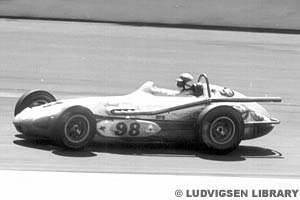 With everyone's pit stops over, the leaders got down to business and at one point Clark closed to four and one-half seconds on Jones. In the pits, the Agajanian crew were flailing their arms urging Jones to go faster every time Old Calhoun passed the pits. By lap 170, Jones was still turning laps over 150 mph, despite a visibly smoking engine, desperately trying to keep the Lotus at bay.
With everyone's pit stops over, the leaders got down to business and at one point Clark closed to four and one-half seconds on Jones. In the pits, the Agajanian crew were flailing their arms urging Jones to go faster every time Old Calhoun passed the pits. By lap 170, Jones was still turning laps over 150 mph, despite a visibly smoking engine, desperately trying to keep the Lotus at bay.
 In the 1924 Indy 500, Fengler had crashed in practice in the north chute in mid-May, broke his collarbone and suffered other injuries, and never made the race as a driver again. In short, standing there with his red fedora hat on and the black flag in his hand, he knew how difficult it was for a man like Parnelli Jones to have come this far and was understandably reluctant to ruin it all for him when victory was in his grasp.
In the 1924 Indy 500, Fengler had crashed in practice in the north chute in mid-May, broke his collarbone and suffered other injuries, and never made the race as a driver again. In short, standing there with his red fedora hat on and the black flag in his hand, he knew how difficult it was for a man like Parnelli Jones to have come this far and was understandably reluctant to ruin it all for him when victory was in his grasp.
"Clark's car owner, Colin Chapman, wanted Chief Steward Harlan Fengler to have the race leader black-flagged. That would have cost Parnelli the race. Fengler was ready to do so and even handed the appropriate flag to starter Pat Vidan. But Agajanian's chief mechanic Johnny Pouelsen talked him out if it. They argued that the crack was at the oil-tank hanger and the oil had already leaked down to that level. Bitter Eddie Sachs and Roger McCluskey (two other drivers) rebutted [later on] that and said they had both spun on Parnelli's oil. The day after the race they were attending a luncheon when Sachs expressed his views a bit too forcefully. Parnelli decked him with a right cross."
Please Contact Us for permission to republish this or any other material from Atlas F1.
|
Volume 9, Issue 21
Atlas F1 Exclusive
The Forgotten Man: Interview with Trulli
Ann Bradshaw: View from the Paddock
Atlas F1 Special
A Tale of Two Chassis
Austrian GP Review
2003 Austrian GP Review
What It's All About
Completing the Set
Of Winning and Whining
Stats Center
Qualifying Differentials
SuperStats
Charts Center
Columns
Season Strokes
On the Road
Elsewhere in Racing
The Weekly Grapevine
> Homepage |